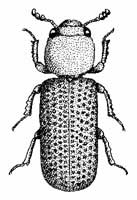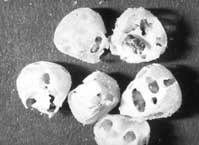Gabriele Stoll
Natural Crop Protection in the Tropics
Letting Information Come to Life
Insect pests in field and Storage
Larger grain borer
Prostephanus truncatus (Coleoptera: Bostrichidae)
Larger grain borer: Adult
Damaged maize grain
Host plants
Maize, cassava, sweet potatoes.
It is reported to breed only in maize and
cassava. The adults can, however, live in and damage many
stored products as well as structural wood and wooden utensils.
Distribution
P. truncatus is an indigenous pest of
stored maize in Central America and has since the 1980s become
established in Tanzania, from where it spread to the
neighbouring countries. Today this pest is also present in West
Africa.
Life cycle
The female lays 30-50 eggs into the
produce (maize, cassava). The larvae develop inside the grain
dust produced by the feeding action of the adults. A life cycle
can be completed within 44 days for males and 61 days for
females. On emergence, the adults seek out grain in either
shelled crop or on cobs.
Damage pattern
The adults bore into the maize grains,
making holes by their tunnelling action and generating large
quantities of dust. The adults prefer grain on cobs more than
shelled grain, probably due to the fact that the loose grain is
more difficult to penetrate.
Control measures
Natural enemies
Parasitoid (larva):
Ascogregarina bostrichidorum
Management
• Regular inspection
Storage facilities
• Shelling of maize and storing it in
suitable containers.
• Store produce in airtight
containers, e.g. metal drums.
• Underground pits may be tested
because the temperature is cool and oxygen levels are reduced,
thus restricting the development of storage pests.
Insect-controlling plants
Castor beans
Neem
Neem
Pyrethrum
Velvet leaf*
10% ethanolic extract
5-10% slurry
1.5% (vol/vol)
0.5% powder (w/w)
2.5-10% slurry
< 10% damage
< 16% damage
Highly effective
< 10% damage
Seed
Seed
Oil
Flower
Leaf, root
* the slurry of the velvet leaf is
extremely bitter, therefore this treatment is suggested for
application on planting seed.
TIERTO found out that using plant material
in the form of a slurry produces better results than plant
powders. In his research the slurry was made by weighing out
powder into 150 ml containers and adding sufficient water to
give a 10% concentration (w/w), and stirring until a smooth
paste was obtained. The treatment was performed by pouring the
grain into prepared slurries and stirring with a rod until all
grains were coated.

